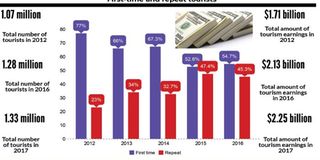What Tanzania's tourism industry needs to bloom

What you need to know:
In 2016 the number of tourists visiting the tourist sites declined to 45.3 per cent from 47.4 per cent a year before.
Dar es Salaam. Economists have suggested that tourism products be diversified, marketing be enhanced, infrastructure be improved and service costs be cut to attract visitors in Tanzania repeatedly.
In 2016 the number of tourists visiting the tourist sites declined to 45.3 per cent from 47.4 per cent a year before.
The number of visitors grew by 21.1 per cent to 1.327 million last year compared with what was posted five years back.
Consequently tourism earnings rose by 22.2 per cent to $2.2 billion (about Sh4.9 trillion at the prevailing exchange rate).
“This implies that we have won promotion to get new visitors but failed to retain them,” said Prof Haji Semboja of the University of Dar es Salaam’s Economics Department.
He said the best indication of whether a tourist will return to visit a given destination is the number of times he or she has been to that destination before.
A survey finding has shown that an overall average length of stay of persons who visited Tanzania in 2016 was nine nights, slightly fewer than 10 nights recorded during the past five years.
In that regard, Prof Semboja called for private service providers to lower the costs and improve the quality of services to make tourists return next time.
Prof Humphrey Moshi of the University of Dar es Salaam’s Economics Department called for improvement of infrastructure in aviation to enable tourists have direct flights to Tanzania.
“A tourist coming to Tanzania does not always have a direct flight, but often has to go through some other countries and catch a connectivity flight, making a trip tiresome,” noted Prof Moshi.
“It is not necessary to have more repeat tourists. We need to do all in our power to get more first-time visitors so that they can be ambassadors to others, about the potentials that we are endowed with.”
Repoa strategic research director Abel Kinyondo called for diversification and promotion of tourism products rather than relying on wildlife tourism to convince tourists that Tanzania is their best destination.
“Satisfaction with a given destination is necessary, but not a sufficient condition to bring tourists back, if they are seeking new experiences.”
The head of the communications unit in the Ministry of Tourism and Natural Resources, Mr Hamza Temba, said the government was working hard to diversify tourism products.
There is a process of identifying suitable areas for beach tourism in Tanga, Coast, Dar es Salaam, Lindi and Mtwara regions.
For the country to have more successful tourism industry, it must be more easily reachable, experts say. That can be done by having a less problematic visa procedure.
According to Dr Kinyondo, for the tourists of several countries where Tanzania does not have embassies, applying and receiving visas is laborious, problematic, expensive, time consuming and frustrating.
Kenya, according to him, grants visa on arrival, Uganda allows travellers to apply for and receive the visa online, making the application and processing easy, quick and relatively inexpensive.
“If things remain unchanged, tourists may end up losing hope and give up on Tanzania and simply go to neighboring countries like Kenya and Rwanda or to some other countries which offer similar attractions,” warned Dr Kinyondo.
Also, if the country is to attract repeat tourists it is important to promote middle-income retirees, a potentially rewarding market segment for Tanzania, a according to a book titled ‘Making Tourism Work for Tanzania, by DrKinyondo and Prof Riccardo Pelizzo, an associate professor of Public Policy and the vice-dean for academic affairs in the Graduate School of Public Policy of Nazarbayev University.
To appeal for the market segment, according to the book, several successful tourist destinations in South Asia have created visas for retired people who get a chance to spend up to 180 days a year in their countries.
For its part Singapore, the success of its tourist industry is to a large extent made possible by the fact that it has also a very high percentage of repeat tourists, standing at 75 per cent, the highest value in South East Asia. Two years back, Singapore had 2.894 million tourists and $24.8 billion (about Sh56 trillion at the current exchange rate), which was a 13.9 per cent increase from the year before.




